From Slow to Speedy: Your Guide to Unclogging Any Sink
By Brian on August 26, 2025
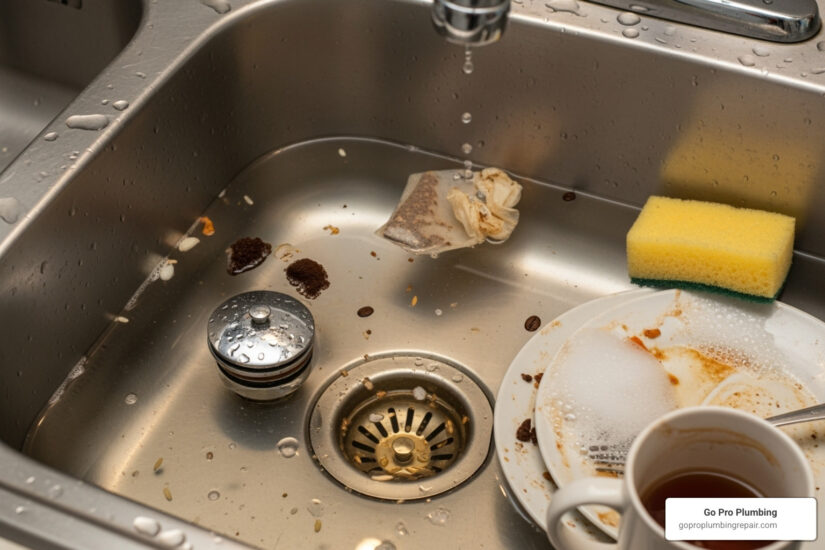
Why Every Homeowner Needs Reliable Clogged Kitchen Sink Solutions
Clogged kitchen sink solutions are essential for every homeowner. As one of the most-used fixtures in a home, a slow or backed-up kitchen sink can bring your daily routine to a grinding halt.
Quick Solutions for Clogged Kitchen Sinks:
- Boiling Water – Pour slowly down metal pipes to dissolve grease
- Sink Plunger – Use proper technique with shallow rubber cup
- Baking Soda & Vinegar – Natural method for minor clogs
- Drain Snake – Mechanical removal for stubborn blockages
- P-Trap Cleaning – Remove and clean the curved pipe under sink
The most common cause of kitchen sink clogs is grease buildup, followed by food debris. You’ll know you have a problem when you see standing water, hear gurgling sounds, or notice bad odors coming from your drain.
Most clogs start small and worsen over time. The good news is that many can be cleared with simple DIY methods using items you already have at home.
Warning signs your sink needs attention:
- Water drains slowly or not at all
- Gurgling noises from the drain
- Unpleasant smells
- Water backing up into the sink
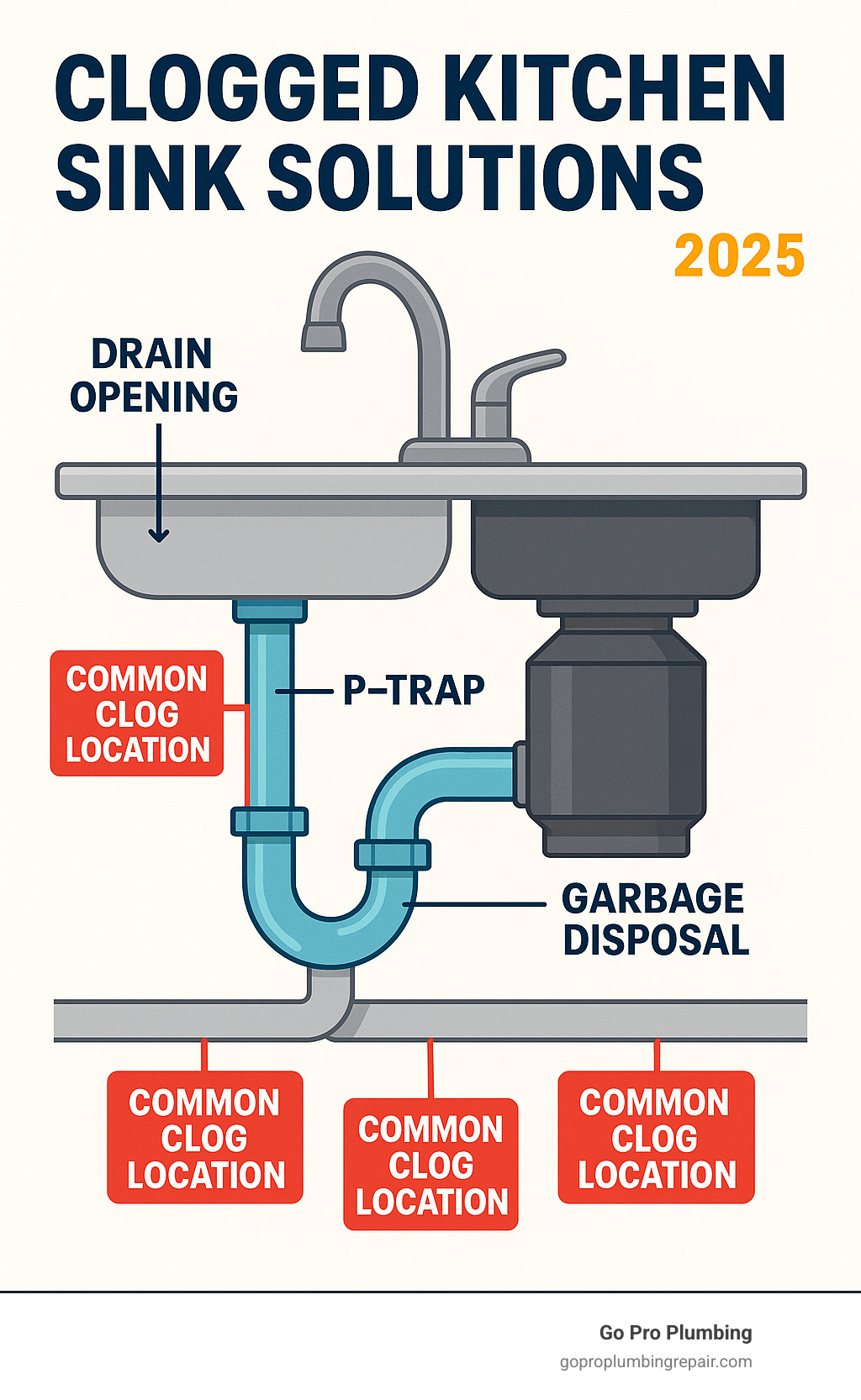
Simple Clogged kitchen sink solutions word guide:
What’s Causing the Blockage? Common Kitchen Sink Culprits
Understanding the culprits behind your drainage issues is the first step toward finding effective clogged kitchen sink solutions.
Grease buildup is the biggest troublemaker. Hot cooking oils, fats, and grease flow down as liquids but quickly cool and solidify inside your pipes. This creates a sticky coating that catches other debris.
Food debris is a close second. Even with a garbage disposal, tiny particles can settle in your pipes. Coffee grounds are sneaky; they don’t dissolve and can clump together. Eggshells have membranes that stick to pipes, creating nets that catch other debris.
Starchy foods like pasta, rice, and potato peels are nightmares for your drain. They absorb water and expand into a gluey mess that can block pipes.
Soap scum, a mix of soap and hard water minerals, creates a sticky film that grabs grease and food, turning small clogs into big problems.
Sometimes foreign objects like a dropped spoon or bottle cap can cause instant blockages.
If you’re dealing with unpleasant odors, organic matter is likely decomposing in your pipes. Check out our guide on Smelly Sink Drain for targeted solutions.
Foods that should never go down your drain:
- Grease, fats, and oils (collect in a jar and toss in trash)
- Coffee grounds and tea leaves
- Eggshells and nutshells
- Pasta, rice, and other starchy foods
- Potato peels and fibrous vegetables
- Bones and fruit pits
- Celery, corn husks, and stringy vegetables
Being mindful of what goes down your kitchen sink is your best defense against these common clog culprits. Prevention keeps your drains flowing freely.
Your Step-by-Step Guide to DIY Clogged Kitchen Sink Solutions
When your kitchen sink clogs, don’t panic. Most blockages are manageable with basic tools and know-how. Here’s your toolkit for fixing the problem without calling a pro.
Before you start, prioritize safety. Always wear sturdy rubber gloves to protect your hands. If using chemical products, eye protection is essential. Keep a bucket handy under your sink to catch any water spills.
Each DIY method has its strengths. Knowing when to use what can save you time and frustration:
| Method | Effectiveness (for kitchen clogs) | Cost (typical) | Difficulty | Best For |
|---|---|---|---|---|
| Boiling Water | Low to Medium | Very Low | Very Easy | Minor grease clogs |
| Plunger | Medium to High | Low | Easy | Most common, relatively fresh clogs |
| Baking Soda & Vinegar | Low | Low | Easy | Minor organic clogs, odor removal |
| Drain Snake/Auger | High | Medium | Medium | Stubborn, deeper clogs, physical blockages |
Start with Boiling Water (For Metal Pipes)
If you suspect a grease buildup, boiling water can be a simple, effective solution. The heat application melts solidified grease, allowing it to flow down the pipes.
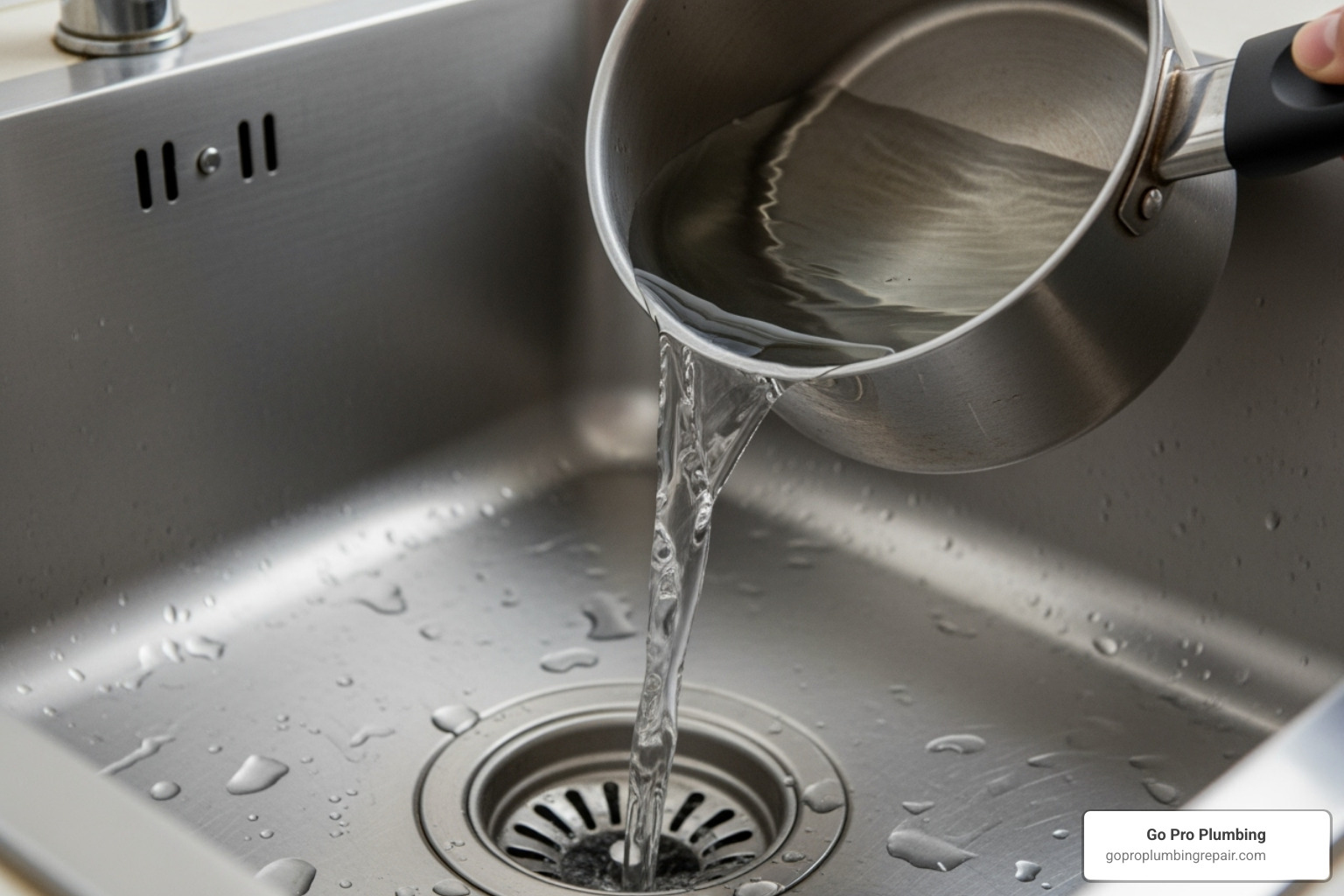
First, bail out any standing water. Bring a large pot of water to a rolling boil and pour it directly into the drain in a steady stream. Pour it slowly to let the heat work. Wait a few minutes, then repeat if needed.
However, this method has important cautions. If you have PVC pipes, boiling water can cause damage; use very hot tap water instead. Composite sinks can also crack or warp from extreme heat, so only use this method for metal sinks like stainless steel.
Using a Plunger: A First-Line Defense
A plunger is a powerful tool that uses suction and pressure to dislodge clogs. Use a sink plunger with a flat rubber cup, not the flanged one for toilets.

Leave 1-2 inches of water in the sink to submerge the plunger cup. For double sinks, you must seal the second drain with a wet rag or stopper. Place the plunger firmly over the drain to create a tight seal.
For the plunging technique, pump vigorously 10-12 times while maintaining the seal. This creates a vacuum that pushes and pulls on the clog. On the last pump, pull the plunger away quickly. A gurgling sound means you’ve succeeded. Flush the sink with hot water for several minutes to clear remaining debris.
The Baking Soda and Vinegar Method
This natural cleaning method uses a chemical reaction to break down minor clogs and has a great deodorizing effect.
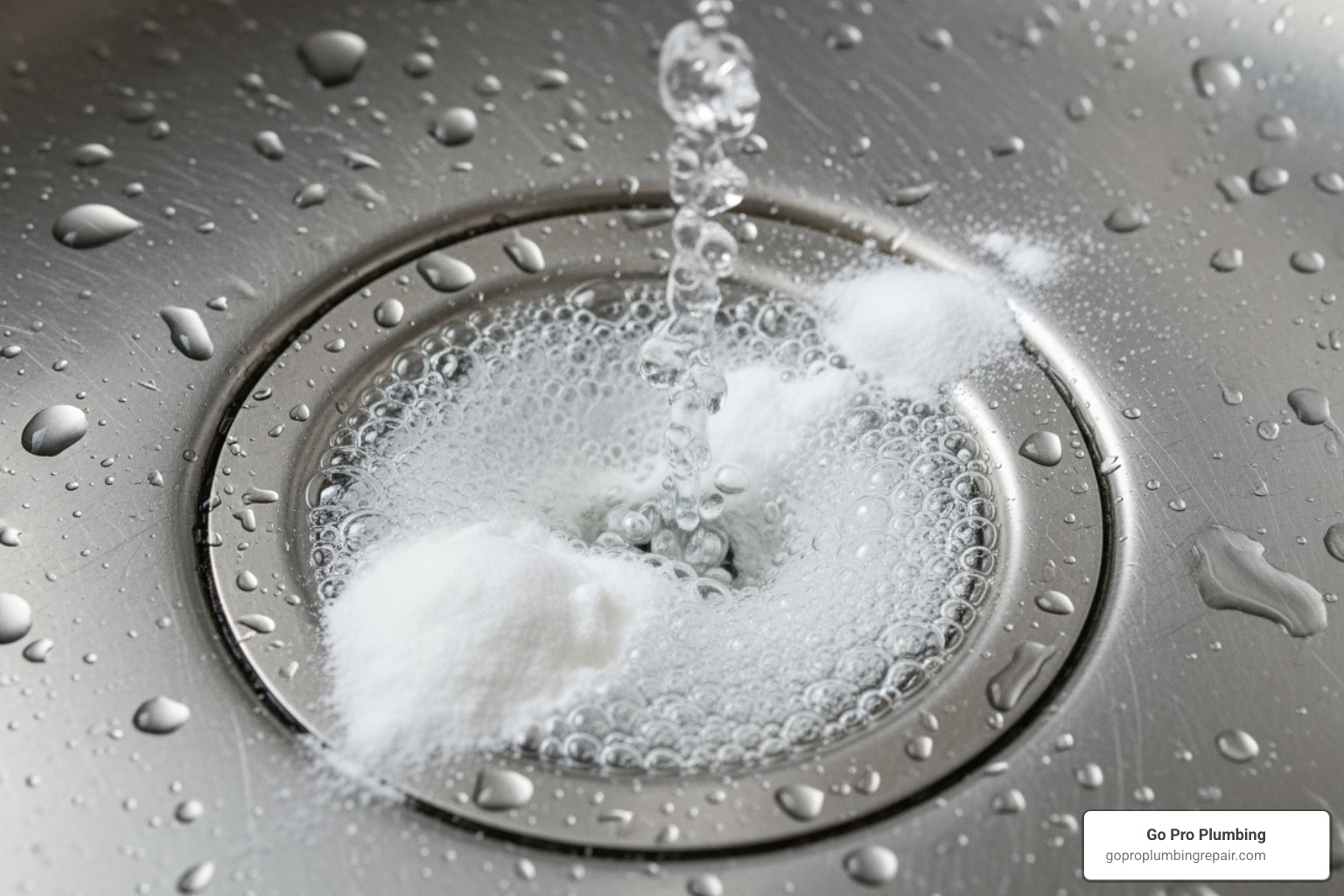
Here are the step-by-step instructions: Pour hot water down the drain. Pour one cup of baking soda into the drain, followed by one cup of white vinegar. You’ll hear it fizz. Quickly cover the drain with a stopper or wet rag to direct the action down into the pipes. Let it work for 15-30 minutes, then flush with another pot of hot water.
This method is best for minor clogs and regular maintenance.
Using a Drain Snake for Stubborn Clogged Kitchen Sink Solutions
For stubborn clogs, a drain auger (or snake) is a mechanical tool for reaching deeper blockages. This tool physically breaks up or retrieves blockages.
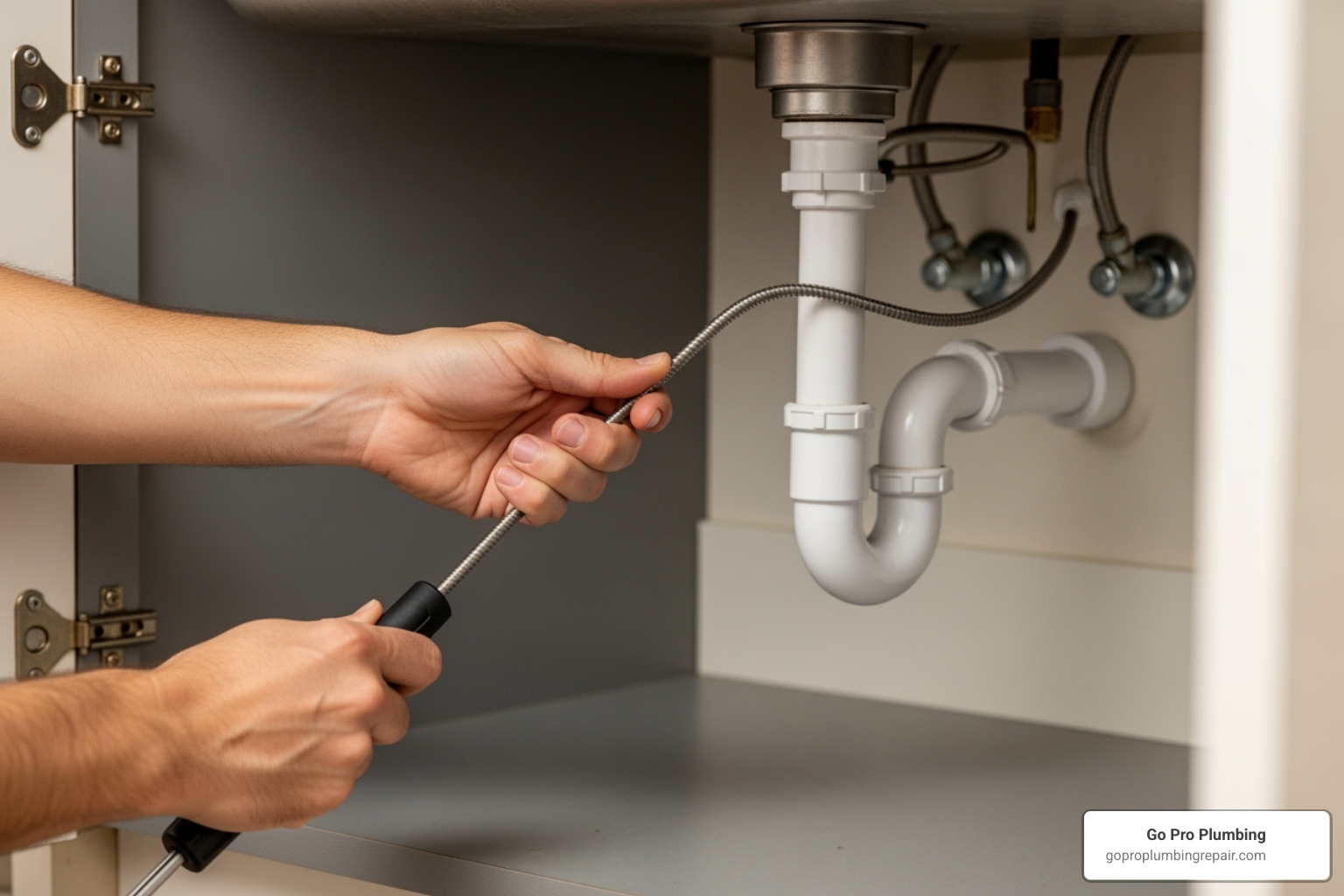
Place a bucket under the P-trap (the U-shaped pipe). You may need P-trap removal for better access. Unscrew the slip nuts, remove the trap, and clean out any gunk.
How to operate a snake: Feed the snake into the pipe until you feel resistance. Tighten the thumbscrew and turn the handle while pushing forward. This action breaks up the clog or hooks it for retrieval. When the blockage gives way, slowly pull the snake out. Be ready for a messy retrieval; have a trash bag handy. Reassemble everything, run hot water, and check for leaks.
For tough blockages, our Drain Cleaning Services team has professional-grade equipment.
A Note on Chemical Drain Cleaners
We advise caution with chemical drain cleaners. They promise quick fixes but can cause serious drawbacks and bigger problems.
Chemicals pose risks to pipes, especially older or plastic ones, which can be corroded or damaged. They also raise environmental concerns. These products are highly corrosive, posing a safety risk to skin and eyes. If they fail, you’re left with a sink full of dangerous, caustic water. They are also often ineffective on certain clogs, like those caused by foreign objects.
Enzymatic cleaners are a safer alternative for maintenance. They use natural enzymes to break down organic matter over time, making them gentler on pipes and the environment. They are best for prevention, not for clearing severe blockages.
There are safer, more effective clogged kitchen sink solutions that won’t put your plumbing at risk.
The Garbage Disposal Dilemma: Clearing and Care
Your garbage disposal can cause major sink clogs. When it acts up, it can take the whole drain system with it. Let’s walk through some simple troubleshooting steps.
Safety first, always: Never stick your hands into a garbage disposal, even when off. The blades are sharp. Use tongs or pliers to retrieve objects.
The most common problem is a humming noise without grinding, which usually means the grinding plates are jammed. Here’s how to fix it:
Turn off the power at the wall switch and the circuit breaker. Look underneath the disposal for a small red reset button and push it. If it pops out, wait 10 minutes before trying again.
Most disposals come with a 1/4-inch Allen wrench. Insert it into the hexagonal hole on the bottom of the unit and crank it back and forth. This manually turns the plates to free the jam.
With the power still off, use a flashlight to look for foreign objects like silverware or fruit pits. Carefully remove anything you find with tongs or pliers.
If the disposal has no power at all, check the reset button first, then check your circuit breaker.
Running cold water is crucial. Turn on the cold tap before, during, and for 30 seconds after using the disposal. This flushes particles through the drain system.
Feed the disposal small amounts of food scraps at a time. Avoid its worst enemies: coffee grounds, eggshells, fibrous vegetables, and especially grease.
To keep your disposal clean, grind a few ice cubes periodically. For extra cleaning and freshening, you can freeze vinegar in ice cube trays or grind citrus peels.
By caring for your garbage disposal, you’ll prevent many issues that require clogged kitchen sink solutions.
Keeping Drains Clear: Proactive Prevention Tips
An ounce of prevention is worth a pound of cure for kitchen sink clogs. Adopting simple habits can keep your drains flowing freely and save you from future headaches, which is the best of all clogged kitchen sink solutions.
The easiest step is to install drain screens or strainers. They sit in your drain opening and catch food particles and debris before they enter your pipes. Clean them out regularly, tossing the waste in the trash.
Next, focus on proper grease disposal. Grease, fats, and cooking oils are the primary cause of drain clogs. Never pour them down your sink. Let grease cool in a can or jar, and once it solidifies, scrape it into the trash. Wipe greasy pans with a paper towel before washing.
Scraping plates before washing is another key habit. Scrape all food bits into the trash or compost bin before rinsing. These small bits add up over time.
If you have a garbage disposal, be mindful about what goes down. Keep problem foods like coffee grounds, eggshells, fibrous vegetables, and starchy foods out of it. Grind food in small batches and always run cold water before, during, and after.
Make a habit of regular flushing with hot water. After using the sink, let hot tap water run for 30 seconds to flush away lingering particles and help prevent grease from solidifying.
For ongoing maintenance, consider using enzymatic cleaners periodically. They use natural enzymes to gradually break down organic matter and are much safer than harsh chemicals.
Make these habits second nature for everyone in your household. It’s much easier to prevent a clog than to deal with one. Regular professional maintenance can also help. Learn more about our Plumbing Maintenance Work. For those on a septic system, proper care is even more critical; see the EPA’s guide on How to care for your septic system.
By adopting these preventive measures, you’ll dramatically reduce your chances of needing emergency drain cleaning.
When DIY Isn’t Enough: Signs You Need a Professional Plumber
While DIY clogged kitchen sink solutions are satisfying, some clogs require professional help. Knowing when to call a pro is a smart decision that can prevent a manageable problem from becoming an expensive disaster.
Multiple clogged drains are a major red flag. If your kitchen and bathroom sinks are clogged, the problem is likely in your main sewer line. This requires professional equipment to diagnose and clear.
Recurring clogs are another sign that your DIY efforts are only a temporary fix. If you clear a drain only for it to clog again soon after, there’s likely a more significant buildup deeper in the pipes.
A persistent foul odor that doesn’t go away with cleaning indicates a more serious issue, such as trapped organic matter deep in the drain or a problem with your sewer vent system.
Water backing up into your sink is a clear sign to call a pro, especially if it happens when you use other fixtures like a toilet or washing machine. This points to a significant blockage in your main drain line.
If you’ve had no success with DIY methods after trying several approaches, it’s time to step back. Continuing to force a stubborn clog can damage your pipes, making the professional repair more complex and costly.
At Go Pro Plumbing, we understand a clogged sink disrupts your routine. We offer outstanding customer service and same-day service for urgent plumbing problems throughout Northern California, including Sacramento and Rancho Cordova. We have the professional-grade equipment and expertise, including our Emergency Plumbing Repair Kit, for situations that can’t wait.
Get Your Drains Flowing Freely Today
Dealing with persistent clogs is frustrating. When your best DIY efforts for clogged kitchen sink solutions fail, it’s time to call a professional.
Our team at Go Pro Plumbing has professional equipment to handle any clog. Our arsenal includes powerful hydro-jetting systems that blast away years of grease and buildup with high-pressure water. We also use advanced camera inspection technology to see inside your pipes and identify the exact cause of the clog.
The best part? We know a clogged sink is an emergency. That’s why Go Pro Plumbing offers same-day service throughout Sacramento and Northern California. Our goal is to fix the problem and get your life back to normal quickly.
Whether you’re in Rancho Cordova with a stubborn kitchen sink or anywhere else in Northern California with recurring drain issues, we have the expertise to solve it right the first time.
Ready to say goodbye to that clog for good? Contact our drain cleaning experts for fast, reliable service in Sacramento and Northern California and let us restore your kitchen to its happy, functional self!
